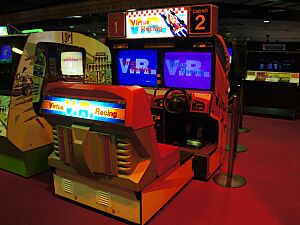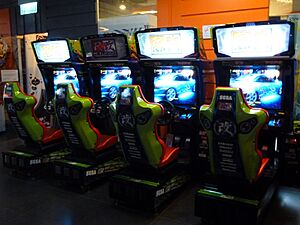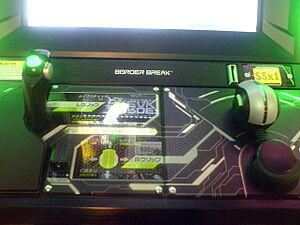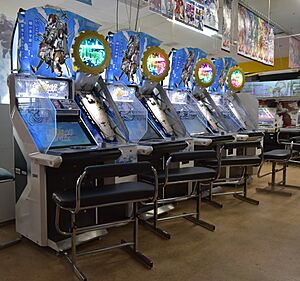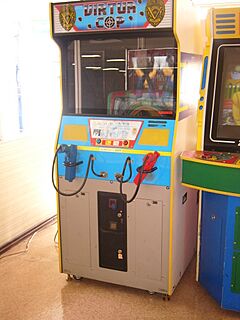Sega AM2 facts for kids

Logo used as SEGA-AM2 Co., Ltd.
|
|
|
Trade name
|
Sega AM2 |
|---|---|
|
Formerly
|
Studio 128 (1986-1988) Sega R&D8 (1988-1990) Sega AM R&D Dept. #2 (1990-1999) Sega Software R&D Dept #2 (AM2) (1999-2000) AM2 of CRI (2000-2001) SEGA-AM2 Co., Ltd. (2001-2004) AM R&D Dept. #2 (2004-2011) Sega R&D2 (2011-2015) Sega Interactive R&D2 (2015-2020) |
| Division | |
| Industry | Video games |
| Predecessor | Sega R&D1 Sega R&D2 |
| Founder | Yu Suzuki |
| Headquarters |
,
Japan
|
|
Key people
|
|
| Products | Arcade games, video games |
| Parent | Sega |
Sega AM Research & Development No. 2, often called SEGA-AM2 Co., Ltd., is a special team at the Japanese video game company Sega. This team creates exciting video games. Yu Suzuki, a famous game creator, was the first person to lead this team. He had already made popular arcade games like Hang-On and Out Run for Sega.
AM2's first big game was Virtua Racing in 1992. After that, they made the super popular games Virtua Fighter and Daytona USA. For the rest of the 1990s, AM2 focused on making more arcade games. They were especially good at fighting games and racing games.
In 2000, AM2 became part of another company called CSK Research Institute. A year later, it changed its name to SEGA-AM2 Co., Ltd. One of their games, Shenmue, was very expensive to make. Even though it got good reviews and sold well, it didn't make enough money to cover its costs.
Yu Suzuki moved on from AM2 in 2003. Hiroshi Kataoka then became the new head of the team. In 2004, Sega was bought by Sammy Corporation. AM2 then became a part of Sega again. Since then, the team has kept making arcade games like Border Break and the Hatsune Miku: Project DIVA series. They also make games for smartphones in Japan. Many games made by Sega AM2 have been very important. They have brought new ideas and technology to the video game world.
Contents
How AM2 Started and Grew
Yu Suzuki's Early Days at Sega
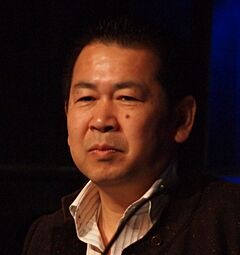
Yu Suzuki joined Sega in 1983 as a programmer. Back then, Sega only had one team for making games. In his first year, he created a 2D boxing game called Champion Boxing. It was for Sega's first home game console, the SG-1000. Suzuki said that Sega's leaders were so impressed with the game. They even put the SG-1000 console into an arcade machine to release it in arcades! He became a project leader in his first year.
Suzuki's next big project was Hang-On, a motorcycle racing game. He wanted to make a 3D game, but the technology was limited. So, he helped design Sega's new Super Scaler arcade board. This board used 16-bit graphics and could make sprites look bigger or smaller. This made them seem 3D. Hang-On was very popular and sold a lot of copies for Sega. Suzuki continued his success with games like Space Harrier, Out Run, and Enduro Racer.
His team moved to a more private place called "Studio 128". There, they made After Burner and Power Drift. He also worked on G-LOC: Air Battle and the special R360 arcade cabinet. Another game designer, Toshihiro Nagoshi, joined Sega in 1989. He became part of Suzuki's team.
Forming AM2: A New Era for Sega Games
After Power Drift was released, Sega started to divide its arcade game teams. These became the Amusement Machine Research and Development teams, or AM teams. Yu Suzuki became the general manager of Research and Development No. 2, known as Sega AM2. Suzuki said that Sega had about 600 people working on game development. AM2 started with about 100 people. He also mentioned that this split happened because computer graphics technology was getting much better.
Around the time AM2 was formed, Suzuki's team moved back to the main office. Then they moved to another building nearby. Suzuki liked to keep his work secret. Once, even Sega's president, Hayao Nakayama, was not allowed to enter their workspace!
The first game AM2 developed was Virtua Racing. About 10 people started working on it, and 25 people finished it after a year. The Model 1 arcade board, which the game ran on, took about three years to create. AM2 also made a version of the game for the Sega Genesis home console. The magazine Next Generation said that AM2 "changed how people saw polygons in games" with Virtua Racing.
After Virtua Racing, AM2 split into two teams. One team started working on Virtua Fighter. The other team began making Daytona USA. Suzuki wanted to make a game with many moving parts, like a soccer or rugby game. But the Model 1 board wasn't powerful enough. So, he decided to make a game with only two moving characters at a time. Since Street Fighter II was very popular, he chose to make a 3D fighting game to compete. Suzuki wanted Virtua Fighter to be realistic but also fun. Virtua Fighter became a huge hit in Japan. Its Sega Saturn console version sold almost as many copies as the console itself.
For Daytona USA, Toshihiro Nagoshi was the director and main designer. Yu Suzuki was the producer. The idea for the game came from Tom Petit, who led Sega Enterprises USA. He wanted it to show off Sega's new Model 2 arcade board. Sega wanted Daytona USA to be better than Ridge Racer, a game by Namco. To make Daytona International Speedway look real, the developers used satellite imagery. They also sent staff to take photos of the track. Nagoshi even walked a full lap to understand the turns. Daytona USA came out in Japan in August 1993 and worldwide in March 1994. AM2 made the Saturn version in April 1995. This Saturn game was available when the console launched in Western countries. Daytona USA was very popular in arcades. The twin cabinet version won an award in 1995 for its high sales. In 2002, Sega said it was one of the most successful arcade games ever.
During the rest of the 1990s, Suzuki mainly focused on the Virtua Fighter series for arcades. He also produced other games. AM2 then released Virtua Cop and Virtua Fighter 2 for the Model 2 board. Virtua Fighter 2 was made in just twelve months. It was even more successful in Japan than the first game. In 1996, Suzuki said he wanted to be a pioneer in the arcade industry, not just copy others. He also said the palm tree logo of AM2 meant trust and peace of mind. Other games made by AM2 in the late 1990s included Virtua Cop 2, Fighting Vipers, Daytona USA 2: Battle on the Edge, and SpikeOut. Daytona USA 2 and SpikeOut used the more advanced Model 3 system board.
Changes and New Directions for AM2
In April 2000, a company called CSK Research Institute (CRI) took over managing AM2. CRI was part of CSK Corporation, which owned Sega at the time. Yu Suzuki remained in charge. Also in 2000, Sega changed how its game development teams worked. They created nine smaller, independent studios, each led by a top designer. These studios were encouraged to try new things. During the making of Shenmue, Toshihiro Nagoshi asked for his own studio and left AM2.
AM2 developed Shenmue, which Sega hoped would be a huge hit for its Dreamcast console. It was an action-adventure game about a character named Ryo Hazuki trying to get revenge for his father's murder. The game was special because it showed a very detailed version of the Japanese city of Yokosuka. This level of detail was new for video games. It had a day/night cycle, changing weather, and characters with their own daily routines. You could even pick up and look closely at objects. The game also introduced the modern Quick-time event (QTE). Shenmue cost a lot of money to make, more than planned. It was rumored to have cost Sega over $50 million. It was meant to be an 11-part story but was later shortened to three games. According to Peter Moore, who led Sega of America, Shenmue sold "extremely well." However, it couldn't make a profit because not enough Dreamcast consoles were sold. The high cost also made it hard for the game to be profitable. Its sequel, Shenmue II, cost much less to make.
Besides the mixed feelings about Shenmue, some people felt that the Dreamcast era was not as good for AM2 as earlier years. For example, F355 Challenge was a great arcade game but didn't do as well on home consoles. Also, the home version of Virtua Fighter 3 was not as good as the arcade version. The Virtua Fighter series made a big comeback with the highly praised Virtua Fighter 4. This game was released only on the PlayStation 2 console. In Japanese arcades, Virtua Fighter 4 was very important because of its VF.NET system. This system allowed arcade games to connect online. The "quest mode" in Virtua Fighter 4: Evolution on PlayStation 2 used information from players in Japan who played through VF.NET.
In 2001, AM2 of CRI changed its name to SEGA-AM2 Co., Ltd. After working as a producer on Virtua Cop 3 and OutRun 2, Yu Suzuki left AM2 on October 1, 2003. He started a new studio with Sega called Digitalrex. He became a non-executive board director. Hiroshi Kataoka was put in charge of AM2. Kataoka had led research and development at AM2 for a year. He had worked on many Sega projects, from Space Harrier to Virtua Fighter 4 Evolution. Makoto Osaki became AM2's head of development, reporting to Kataoka. At the same time, some of Sega's other studios merged. However, AM2 did not merge with any other studio.
AM2 Today: Arcade and Mobile Games
In mid-2004, Sammy Corporation bought a large part of Sega. They created a new company called Sega Sammy Holdings. Sega and Sammy became parts of this larger company. Both companies still worked on their own, but their main offices merged. Before Sammy bought Sega, Sega had already started bringing its smaller companies back into the main company. This was finished by October 2004. Sega also changed its development studios again. They combined them into bigger groups like Global Entertainment and Amusement Software.
AM2 kept making games after these changes. Virtua Fighter 5 came out in 2007. An updated version, Virtua Fighter 5 R, was released the next year. The last version of the Virtua Fighter series was Virtua Fighter 5: Final Showdown, released for consoles. Ghost Squad, a game like Virtua Cop, came out in arcades and on the Wii in 2008. AM2 has also made games for the Hatsune Miku: Project DIVA series. They also created many free-to-play smartphone games in Japan, such as Soul Reverse Zero. Some games have also been made for consoles, like Hatsune Miku: Project Diva Mega 39’s for Nintendo Switch. AM2 started working with the Hatsune Miku brand by adding items to Virtua Fighter 5 R and the racing game R-Tuned: Ultimate Street Racing. When the PSP game Hatsune Miku: Project DIVA was being made, AM2 decided to create an arcade version. They also developed the holographic images for Hatsune Miku's live concerts. The visuals for these projects were based on the Virtua Fighter 5 game engine. Makoto Osaki said this time was the most stressful for him since Shenmue.
A big success for AM2 has been the Border Break game series. The team partly made this game because they were impressed by the Virtua Fighter 5 team. They also wanted to make a competitive game. The arcade game came out in 2009 and was updated many times. These updates included Border Break Union in 2012, Border Break Scramble in 2015, and Border Break X in 2017. A PlayStation 4 version was released in 2018. In 2019, Border Break celebrated its 10th Anniversary. Other AM2 games that received long-term support in arcades are Quest of D, Sega Network Taisen Mahjong MJ, and Shining Force Cross. Hiroshi Kataoka compared the fun of these online arcade games to online multiplayer games (MMOs). But he noted that collectible cards and a strong community made them different from typical PC MMOs. According to Paul Williams, CEO of Sega Amusement International, these types of core games are only possible in Japan. This is because Sega owns its own arcade chains and can set up online systems. The latest effort, Soul Reverse, was made to be a fantasy version of Border Break. It lasted a year, launching in 2018 and shutting down its online features in 2019. The game was not well-liked by Japanese arcade players. It took four years to create. Currently, AM2 staff are working on arcade games like KanColle Arcade and Fate/Grand Order Arcade. They are also working on an updated version of Virtua Fighter 5, called Virtua Fighter 5: Ultimate Showdown. This game was made with Ryu Ga Gotoku Studio.
As of 2014, Hiroshi Kataoka was still in charge of AM2. Today, he is an executive at Sega. He oversees arcade engineers and the technology behind games made in the engineering division.
Popular Games from AM2
AM2 has developed many arcade and video game series. These include Daytona USA, Virtua Fighter, OutRun, Virtua Cop, Virtua Striker, Fighting Vipers, and Shenmue. Other games made by the studio are Scud Race, Sonic the Fighters, 18 Wheeler: American Pro Trucker, F355 Challenge, Outtrigger (video game), and Soul Reverse. AM2 has also made smartphone games for players in Japan.
Among AM2's games, the Virtua Fighter series has earned the most money in Japanese arcades. The Hatsune Miku: Project Diva series has sold over 6 million copies by 2018. As of March 2012, the game Border Break had earned about 8.1 billion Japanese Yen from arcade machine sales. This is more than US$100 million.
Game journalists have often called AM2 "legendary" in game development, especially when Yu Suzuki was leading it. Aaron Souppouris from Engadget said that AM2 used to make games that set the standard for their types. He called the team Sega's "most-storied division." While he noted changes in their focus recently, Souppouris still called the Hatsune Miku series "admittedly excellent." In 1995, Edge magazine called Suzuki "the legendary head of AM2, Sega's main arcade game operation." Also in 1995, Next Generation magazine said that AM2's repeated success came from making high-quality games regularly. IGN's Travis Fahs stated that "AM2 has been the favorite son of the arcade division... Without AM2, SEGA would not have been able to dominate the arcades the way that they did." Video game researcher Ken Horowitz said that AM2 became the most famous of Sega's in-house teams. He added that the studio created "ground-breaking classics."
| Title | Year released | Platform | |
|---|---|---|---|
| Hang-On | 1985 | Sega Hang-On hardware | |
| Space Harrier | Sega Space Harrier hardware | ||
| Out Run | 1986 | Sega OutRun hardware | |
| After Burner | 1987 | Sega X Board | |
| After Burner II | |||
| Power Drift | 1988 | Sega Y Board | |
| Dynamite Düx | Sega System 16 | ||
| Turbo Outrun | 1989 | Sega OutRun hardware | |
| Sword of Vermilion | Sega Mega Drive | ||
| G-LOC: Air Battle | 1990 | Sega Y Board | |
| GP Rider | Sega X Board | ||
| Strike Fighter | 1991 | Sega Y Board | |
| Rent a Hero | Sega Mega Drive | ||
| F1 Exhaust Note | 1991 | Sega System 32 | |
| Arabian Fight | 1992 | Sega System 32 | |
| Virtua Racing | Sega Model 1 | ||
| Soreike Kokology | Sega System 32 | ||
| Burning Rival | 1993 | Sega System 32 | |
| Virtua Fighter | Sega Model 1 | ||
| Daytona USA | 1994 | Sega Model 2 | |
| Desert Tank | |||
| Virtua Cop | |||
| Virtua Fighter | Sega Saturn | ||
| Virtua Fighter 2 | Sega Model 2 | ||
| Virtua Racing | Sega Mega Drive | ||
| Daytona USA | 1995 | Sega Saturn | |
| Virtua Fighter 2 | |||
| Virtua Fighter Remix | |||
| Virtua Striker | Sega Model 2 | ||
| Virtua Cop 2 | |||
| Fighting Vipers | |||
| Virtua Cop 2 | 1996 | Sega Saturn | |
| Virtua Fighter 2 CG Portrait Series | |||
| Virtua Fighter Kids | Sega ST-V, Sega Saturn | ||
| Virtua Fighter 3 | Sega Model 3 | ||
| Fighters Megamix | Sega Saturn | ||
| Fighting Vipers | |||
| Scud Race | Sega Model 3 | ||
| Sonic the Fighters | Sega Model 2 | ||
| Digital Dance Mix Vol. 1 Namie Amuro | 1997 | Sega Saturn | |
| Scud Race Plus | Sega Model 3 | ||
| Virtua Fighter 3tb | |||
| Fighting Vipers 2 | 1998 | ||
| Daytona USA 2: Battle on the Edge | |||
| Daytona USA 2: Power Edition | |||
| Virtua Fighter 3tb | Dreamcast | ||
| Ferrari F355 Challenge | 1999 | Sega NAOMI Multiboard | |
| Outtrigger (video game) | Sega NAOMI | ||
| 18 Wheeler: American Pro Trucker | Sega NAOMI | ||
| Shenmue | Dreamcast | ||
| 18 Wheeler: American Pro Trucker | 2000 | ||
| Ferrari F355 Challenge | |||
| Beach Spikers | 2001 | Sega NAOMI | |
| F355 Challenge 2 International Course Edition | Sega NAOMI Multiboard | ||
| Fighting Vipers 2 | Dreamcast | ||
| Shenmue II | |||
| Outtrigger (video game) | |||
| Virtua Fighter 4 | Sega NAOMI 2 | ||
| Aero Elite: Combat Academy | 2002 | PlayStation 2 | |
| Beach Spikers | Gamecube | ||
| Ferrari F355 Challenge | PlayStation 2 | ||
| Sega Network Taisen Mahjong MJ | Sega NAOMI 2 | ||
| Shenmue II | Xbox | ||
| The King of Route 66 | Sega NAOMI 2 | ||
| Virtua Cop: Elite Edition | PlayStation 2 | ||
| Virtua Fighter 4 | |||
| Virtua Fighter 4: Evolution | Sega NAOMI 2 | ||
| Choujikuu Yousai Macross | 2003 | PlayStation 2 | |
| Virtua Cop 3 | Sega Chihiro | ||
| Sega Network Taisen Mahjong MJ2 | |||
| The King of Route 66 | PlayStation 2 | ||
| OutRun 2 | Sega Chihiro | ||
| Virtua Fighter 4 Evolution | PlayStation 2 | ||
| Ghost Squad | 2004 | Sega Chihiro | |
| Quest of D | |||
| Sega Ages 2500 Vol. 16: Virtua Fighter 2 | PlayStation 2 | ||
| Sega Golf Club | Sega Chihiro | ||
| OutRun 2 SP | |||
| Virtua Fighter 4 Final Tuned | Sega NAOMI 2 | ||
| Virtua Quest | PlayStation 2, GameCube | ||
| Quest of D Ver. 2.0: Gofu no Keisyousya | 2005 | Sega Chihiro | |
| Sega Ages 2500 Vol. 19: Fighting Vipers | PlayStation 2 | ||
| Sega Network Taisen Mahjong MJ3 | Sega Chihiro | ||
| Sonic Gems Collection (Sonic the Fighters) | GameCube, PlayStation 2 | ||
| After Burner: Climax | 2006 | Sega Lindbergh | |
| Quest of D Ver 3.0: Oukoku no Syugosya | Sega Chihiro | ||
| Sega Golf Club Ver. 2006 | |||
| Miyazato San Kyoudai Naizou: Sega Golfclub | PlayStation 3 | ||
| Virtua Fighter 5 | Sega Lindbergh | ||
| Ghost Squad Evolution | 2007 | Sega Chihiro | |
| Ghost Squad | Wii | ||
| Quest of D: The Battle Kingdom | Sega Chihiro | ||
| Sega Network Casino Club | Sega Lindbergh | ||
| Virtua Fighter 5 | Xbox 360, PlayStation 3 | ||
| R-Tuned: Ultimate Street Racing | 2008 | Sega Lindbergh | |
| Sega Network Casino Club Ver. 2 | |||
| Sega Network Taisen Mahjong MJ4 | |||
| Virtua Fighter 5 R | |||
| Border Break | 2009 | Sega RingeEdge | |
| Cyber Troopers Virtual-On Oratorio Tangram | Xbox 360, PlayStation 3 | ||
| Sega Racing Classic | Sega RingWide | ||
| Sega Network Casino Club Ver. 3 | Sega Lindbergh | ||
| Shining Force Cross | Sega RingEdge | ||
| After Burner: Climax | 2010 | Xbox 360, PlayStation 3 | |
| Border Break Airburst | Sega RingEdge | ||
| Cyber Troopers Virtual-On Force | Xbox 360 | ||
| Hatsune Miku: Project DIVA Arcade | Sega RingEdge | ||
| Shining Force Cross Raid | |||
| Virtua Fighter 5 Final Showdown | Sega Lindbergh | ||
| Daytona USA | 2011 | Xbox 360, PlayStation 3 | |
| Sega Network Taisen Mahjong MJ5 | Sega RingEdge | ||
| Border Break Union | 2012 | ||
| Fighting Vipers | Xbox 360, PlayStation 3 | ||
| Hatsune Miku and Future Stars: Project Mirai | Nintendo 3DS | ||
| Shining Force Cross Elysion | Sega RingEdge | ||
| Sonic the Fighters | Xbox 360, PlayStation 3 | ||
| Virtua Fighter 2 | |||
| Virtua Fighter 5: Final Showdown | |||
| Hatsune Miku: Project DIVA Arcade Future Tone | 2013 | Sega Nu | |
| Hatsune Miku: Project Mirai 2 | Nintendo 3DS | ||
| Sega Network Taisen Mahjong MJ | Microsoft Windows | ||
| Sega Network Taisen Mahjong MJ5R | Sega RingEdge | ||
| Shining Force Cross Elysion | |||
| Virtual On: Cyber Troopers | Xbox 360, PlayStation 3 | ||
| Virtua Striker | |||
| Border Break Scramble | 2014 | Sega RingEdge | |
| Shining Force Cross Exlesia Zenith | |||
| Sega Network Taisen Mahjong MJ Mobile | iOS, Android | ||
| Border Break X | 2016 | Sega RingEdge | |
| Hatsune Miku: Project DIVA Future Tone | PlayStation 4 | ||
| Kancolle Arcade | Sega Nu | ||
| Soul Reverse Zero | iOS Android | ||
| Border Break X Zero | 2017 | Sega RingEdge | |
| Sega Network Taisen Mahjong MJ Arcade | Sega Nu | ||
| Border Break | 2018 | PlayStation 4 | |
| Soul Reverse | ALLS UX | ||
| Fate/Grand Order Arcade | |||
| Hatsune Miku: Project DIVA Mega Mix | 2020 | Switch | |
| Virtua Fighter 5 Ultimate Showdown | 2021 | ALLS UX, PlayStation 4 | |
| Hatsune Miku: Project DIVA Mega Mix + | 2022 | Microsoft Windows | |
| Virtua Fighter 3tb Online | 2023 | Arcade | |
| Virtua Fighter 5 R.E.V.O. | 2025 | Microsoft Windows |
See also
 In Spanish: Sega-AM2 para niños
In Spanish: Sega-AM2 para niños
- Sega development studios
- Sega AM1
- Sega AM3
- Amusement Vision
- Smilebit
- Sonic Team
- United Game Artists



